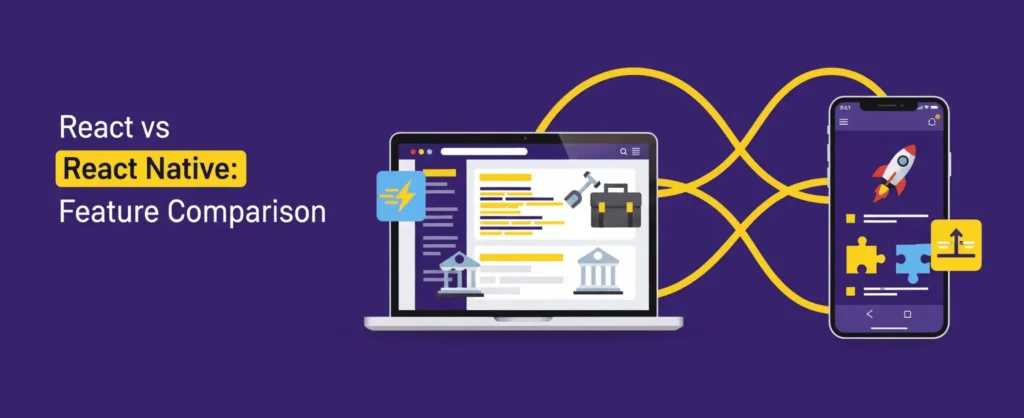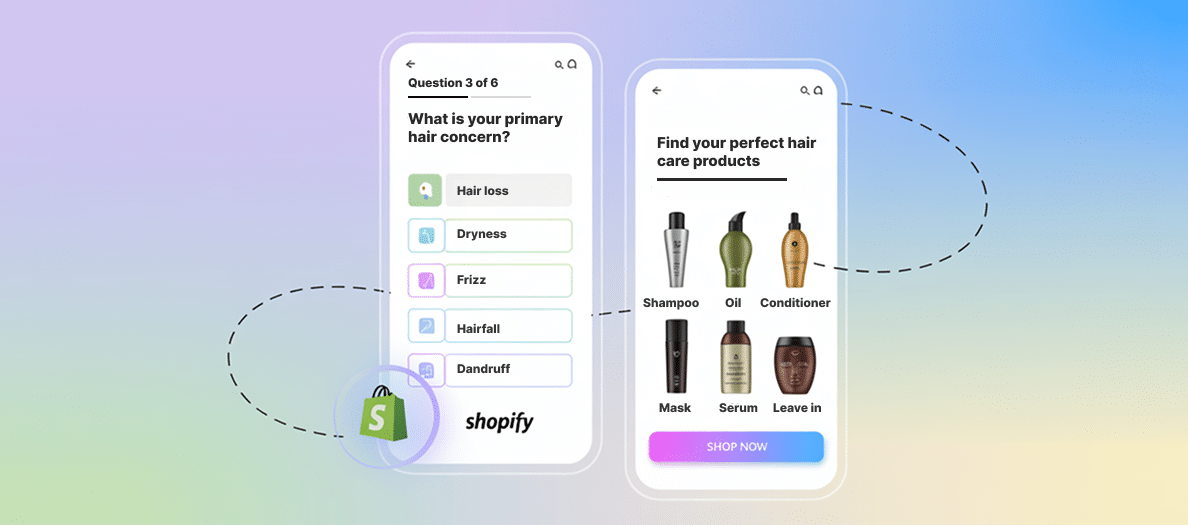
React vs React Native: A Strategic Development Guide 2025
React and React Native are popular frameworks when it comes to front-end development projects. Both frameworks are developed by Meta, have JavaScript as a shared language, and have strong adoption but they are used for very different outcomes in front-end development.
React.js vs React Native – React.js develops scalable and interactive web apps, while React Native builds mobile apps for iOS and Android using the same code—making React.js development a key choice for modern web solutions.
At The Brihaspati Infotech, we have helped many enterprises, startups and SaaS achieve scalable and sustainable outcomes in their front-end development projects.
React vs React Native: Feature Comparison

| Feature | React.js (Web) | React Native (Mobile) |
|---|---|---|
| Primary Use | Building interactive, scalable web applications | Building cross-platform mobile apps with one codebase |
| Performance | High speed rendering for dynamic, data-driven apps | Strong performance, with native modules for heavy apps |
| Ecosystem | Mature, reliable with thousands of proven libraries | Rapidly growing, now stable enough for enterprise use |
| Development Speed | Efficient for web-focused projects | Accelerated delivery for iOS & Android simultaneously |
| Scalability | Enterprise-ready for long-term growth | Scales effectively with selective native integrations |
Our Case Study On Front-End Development
A Software as a Service (SaaS) client came to us with a problem; they needed to build a web portal for enterprise users and a mobile app for students. They weren’t sure whether to build the two platforms separately or use React Native to unify their efforts.
In such cases, businesses often choose to hire React.js developers to ensure the web platform is scalable, efficient, and seamlessly aligned with mobile development.
Our front-end experts analyzed the requirements and developed a hybrid approach to develop both platforms with great results: faster delivery, better costs, and a scalable architecture.
- We built the web portal with React.js because of its flexibility, SEO-friendliness, and enterprise performance, as demonstrated by this portfolio example.
- We built the mobile app using React Native, which helped us save time on development and maximize code reuse, as outlined in this guide on building an activity scheduler app.
- The client was 30% lower in costs and 40% faster in delivery than building separate native builds. This process educated the client on their options, and ensured cost-effectiveness, scalability, and long-term value in their decision-making process in their journey of front-end development.
Selecting the Right Mobile App Development Approach : Factors

Step 1: Platform Orientation
Every front-end project starts with understanding the target platform. React and React Native are designed for different ecosystems.
- React.js is designed for interactive data-driven web applications like SaaS dashboards, portals, or e-commerce sites.
- React Native is designed for mobile-first solutions which successfully deliver on the promise to create apps on both iOS and Android from one code base.
Why this is important: you will waste time and delay your product when you make the wrong platform choice.
Step 2: Performance in 2025
Performance continues to be central to user experience, and both frameworks do well in different ways.
- React.js leverages Virtual DOM implementation for super-fast rendering for complex and dynamic web applications.
- React Native has good overall performance in mobile, but heavy graphics apps may depend on native code for the best performance.
Why this matters: Applications with live updates, streaming, or complicated animations are affected by these bumps in performance and should weigh the options accordingly.
Step 3: Development Cost & Time
For corporations, cost and time to market are nearly as important as the technology itself.
- While React.js cuts down on development time for the web, expanding to mobile generally requires a separate team—making strategic React.js development crucial for building scalable digital solutions.
- With React Native, you can often develop mobile apps faster with one codebase that can be built to the web, essentially decreasing cost and time to launch.
Why this matters: Startups and fast-paced companies reap the benefits of React Native’s fast time to market.
Step 4: Ecosystem Maturity
A strong ecosystem means developers will have more reliable tools and libraries for faster build processes.
- React has been around for ten years and has a well-established ecosystem full of stable and high-quality libraries.
- React Native has matured very quickly and now most significant plugins and UI libraries provide cross platform functionality.
Why does this matter? Businesses can minimize risk if they know they can rely on tried-and-true tools.
Step 5: Long-Term Scalability
A project’s ability to scale will determine its long-term success in front-end development.
- React.js is used in enterprise applications such as CRMs, SaaS, and complex portals.
- On the mobile side, React Native provides a good experience for scaling mobile apps, though typically native code will need to be incorporated for the greatest features.
Why this matters: Picking the correct framework means your project can scale easily, and you avoid expensive rewrites.
Business Benefits of React and React Native Development
React.js
React remains a preferred tool for web-based front-end development.
- SEO-friendly rendering increases web application rankings on search engines.
- Reusable component architecture improves code maintainability and creates faster development cycles.
- Large, stable ecosystem ensures security, flexibility, and ongoing support.
- Seamless backend integration works well with Node.js, Python applications, and other modern technology stacks.
React Native
React Native provides a strategic solution for companies entering the mobile ecosystem. Many businesses choose to hire React Native developers to build robust, cross-platform apps efficiently.
- Cross-platform development allows businesses to develop an app for both iOS and Android without needing to build two code bases.
- Speed to MVP allows for new startups to test the market quicker and pivot when needed.
- Cost savings reduce the need to hire separate teams for both platforms; ultimately saving on the overall development budget.
- Access to native APIs provides near-native performance while maintaining the simplicity of JavaScript.
Overcoming Challenges with React and React Native

Like all technologies, React and React Native have their trouble spots. With the right development expertise, skilled React developers can turn these challenges into opportunities for more elegant and efficient solutions.
- Performance when working with complex React Native apps → We can incorporate native Swift or Kotlin modules into the workflow when optimizing the greatest performance and stability.
- Maintaining a cross-platform codebase → Our modular architecture allows us to create clean, scalable and easy-to-maintain solutions with shared business logic.
- Plugin and library compatibility → We only work with community verified libraries that are well-maintained, to avoid major issues and delays due to incompatibility etc.
Use Cases
When to Use React.js
- Single Page Applications: Dynamic Web Experiences
React is perfect for SPAs, where the user experiences the website without loading alternate pages on the server. These experiences ensure users can click without waiting while experiencing speed. - Complex Web Apps with Dashboards & Live Data
The ability to update the user interface with live data with dashboards. React supports this type of architecture very well. - SEO-Friendly Web Projects with Server-Side Rendering
If combined with Next.js or server-side React frameworks, will increase the Core Web Vitals and SEO rankings to be more visible in search engines. - Multilingual and Global Applications
Plenty of React components integrate with multilingual content management systems, and publish articles in the languages in these regions. - Benefits of Component Reusability in React
In using reusable components logic in React, it eliminates duplication of all the types of React components that you would normally create as part of some giant code base for a site. - Why Integrate React with a Headless CMS?
A headless CMS provides flexibility and scalability in the way developers can integrate and serve content, and with React it is seamless—making content management from creation to consumption easier. To maximize this potential, businesses often hire React.js developers for efficient implementation.
When to Use React Native
- Startups and MVP Development: Faster Time-to-Market
React Native’s single codebase allows for rapid development and is optimized for validating product ideas in record-time. - Cross-Platform Apps with Simple User Interfaces
React Native allows for consistent design and functionality across both iOS and Android without the hassle of maintaining different codebases. - Leveraging Code Reusability Between Web and Mobile
On Web and Mobile, developers can reuse business logic, which requires less effort in development and typically results in lower cumulative maintenance and development costs. - Near-Native Performance for iOS and Android
React Native Apps allow you to deliver smooth performance as if users were using native apps, all while saving costs
Frequently Asked Questions
React is a JavaScript library for building web applications; React Native is a framework for building mobile apps (iOS and Android) using the same React principles.
React is better for startups if you have a predominantly web-based product.
React Native is more appropriate for startups if you need a mobile-first app available on both iOS and Android without two code builds.
React applications are built in the browser, so performance depends on both the browser and server capabilities—skilled React developers can optimize these factors for smoother, faster web experiences.
React Native applications render native mobile components, therefore the performance is close to native performance, making React Native faster compared to other hybrid frameworks. .
React- It is cheaper for businesses if only a website or web app needs to be built.
React Native- It is cheaper for businesses if you need to build iOS and Android apps as you have one codebase for the app versus two separate codebases.
No. Because the core concepts in both frameworks are fairly similar – components, props, and state – you should be able to transition to React Native as you learn new components, styling, and navigation as per mobile.
If a business wants both; many start with React for the web and then extend to React Native for mobile, which allows code-sharing and a similar experience across platforms.
Conclusion: React vs React Native in 2025
The decision between React.js and React Native is less about who’s the “winner” and more about finding the right tool for your digital strategy, in 2025.
React is still the best option for creating SEO-friendly, scalable, and functionality-rich web applications. React Native remains the top choice for cross-platform mobile solutions, offering speed and cost savings—many businesses hire React Native developers to leverage these advantages effectively.
For businesses that want to target both web-based and mobile-based audiences, hybrid options typically provide the best combination of engagement and performance.
At The Brihaspati Infotech, our front-end development experts collaborate with businesses to assess, design, and deliver future-proof digital solutions. Whether you’re building an MVP or scaling to an enterprise-grade platform, we can help ensure your technology choices enable sustained growth and leverage innovation.
Stay Tuned for Latest Updates
Fill out the form to subscribe to our newsletter








